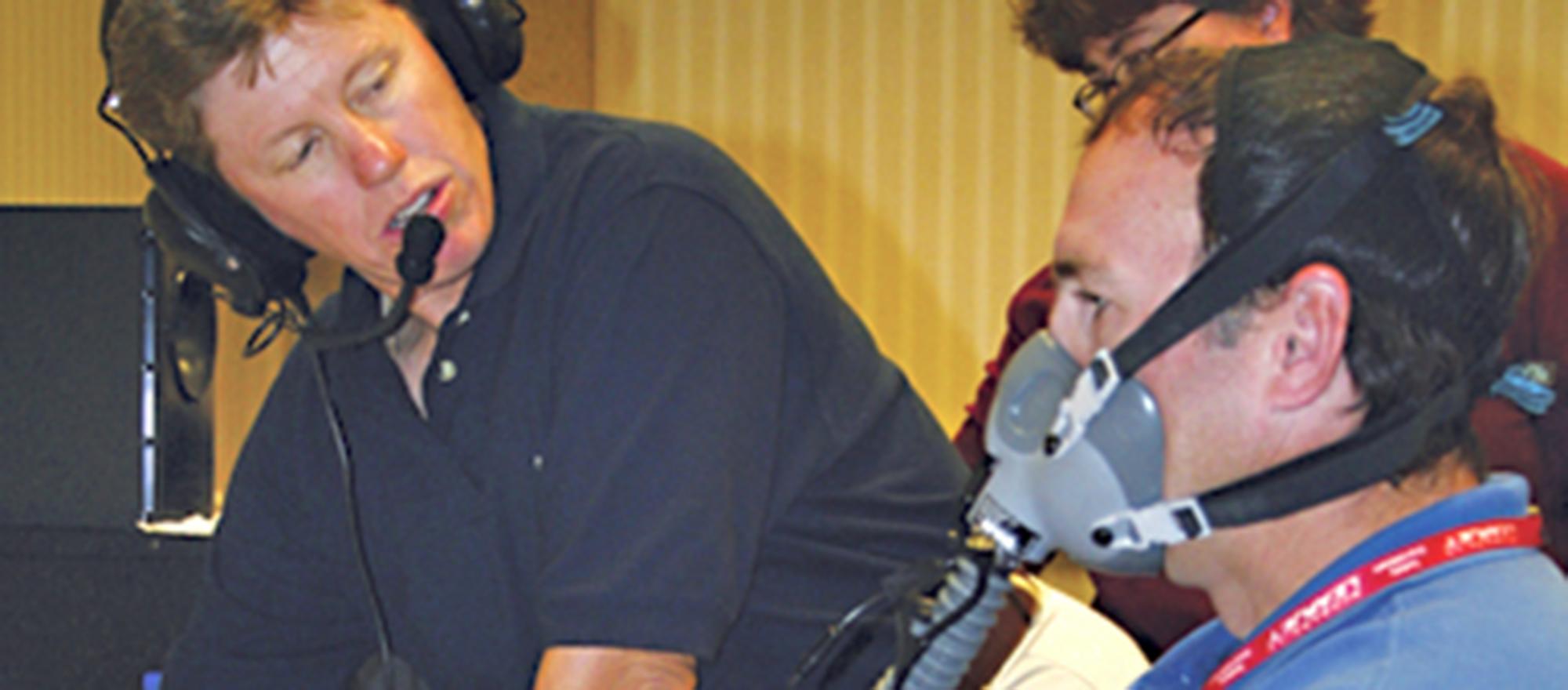
Clearing the air about hypoxia
Would you know what to do in a depressurization emergency?
The oxygen mask drops from the ceiling. You know what to do because your pilots or flight attendant briefed you before takeoff. Give the lanyard a tug, place the mask over your mouth, and breathe.
Quick—there's not much time! You're flying at 45,000 feet, and everyone onboard has about 10 seconds to start breathing oxygen. The alternative: suffer hypoxia and pass out because the cabin has decompressed. That means the air pressure is insufficient for you to breathe. Unless you don the mask or the airplane descends quickly to about 15,000 feet, you will die.
While depressurization is infrequently the cause of accidents, certainly less common than approach and landing problems, it does happen. Two fatal depressurization accidents made an impression on anyone who flies frequently: the Learjet—en route from Orlando, Florida., to Dallas—that flew on to South Dakota and crashed on Oct. 25, 1999, killing pro golfer Payne Stewart and his companions; and the Helios Airways Boeing 737 accident in Greece on Aug. 14, 2005, in which a Hellenic air force fighter pilot observed the first officer slumped motionless on the controls and oxygen masks dangling in the cabin.
In the Payne Stewart accident, the Learjet eventually climbed on autopilot to 46,200 feet. The oxygen in its bottle should have lasted the two pilots and four passengers almost an hour, plenty of time to descend to a safe altitude. Unfortunately, one of the pilot's oxygen masks was fitted with a regulator that pumps 100 percent oxygen all the time, and according to the National Transportation Safety Board accident report, this would have depleted a full bottle in about eight minutes.
The NTSB doesn't know exactly what happened, but said a "possible explanation for the failure of the pilots to receive emergency oxygen is that their ability to think and act decisively was impaired because of hypoxia before they could don their oxygen masks." The report went on to say: "Investigations of other accidents in which flight crews attempted to diagnose a pressurization problem or initiate emergency pressurization instead of immediately donning oxygen masks following a cabin altitude alert have revealed that, even with a relatively gradual rate of depressurization, pilots have rapidly lost cognitive or motor abilities."
In the Helios accident, the pilots failed to notice that the pressurization system switch had been set to "manual" instead of the normal "automatic," and they didn't halt the airplane's climb despite repeated warnings from a cabin altitude warning horn. Passenger oxygen masks dropped from the ceiling automatically after the cabin altitude reached 14,000 feet. However, the 737 provided only 12 minutes of oxygen per passenger, not enough as the airplane continued climbing and flew until it ran out of fuel and crashed.
Numerous safeguards make such incidents rare, however. Some airplanes, like large-cabin Gulfstreams, have an automatic emergency descent system, for example. A significant drop in cabin pressure triggers the system to turn the airplane 90 degrees, then descend at maximum speed to 15,000 feet, where it levels off. In the large Gulfstreams, the pilots and passengers have separate oxygen systems, and at 20,000 feet, there is enough oxygen for eight passengers to breathe for five hours.
There are also FAA regulations concerning oxygen. For example, when flying above 41,000 feet, one pilot must always wear an oxygen mask. For charter flights, when flying a pressurized airplane above 35,000 feet, "at least one pilot at the controls shall wear, secured and sealed, an oxygen mask." Above 25,000 feet for charter and 35,000 feet for corporate jets, moreover, if one pilot leaves the cockpit, the other must don an oxygen mask until the first pilot returns. (Do your pilots perform this simple safety measure? Maybe not, according to the NTSB, which noted in its Payne Stewart report that "pilots do not always use oxygen when required by regulation.")
What can you do to prepare for an oxygen emergency besides ensuring that your pilots comply with regulatory requirements? First, you can take a course such as the three-hour frequent-flyer program offered by AirCare Solutions of Olympia, Wash. During the program, students try on oxygen masks and also breathe air with reduced oxygen content to become familiar with their own hypoxia symptoms using the company's reduced-oxygen breathing device. "[Hypoxia] affects everybody differently," said AirCare CEO Doug Mykol, who added that symptoms can include giddiness, euphoria, sleepiness, cyanosis (blue lips or fingernail beds), combativeness, anger, numbness, shortness of breath and tunnel vision.
The AirCare course teaches passengers not only to recognize hypoxia symptoms but also that they can be key helpers during a depressurization emergency. "Passengers can't fix the problem," Mykol said, "but they can make somebody aware of it."
Don't Wait for a Crisis
The time to prepare for a depressurization emergency is not when an oxygen mask drops from the cabin ceiling. To make sure you're ready for a crisis, consider obtaining emergency training (see accompanying article) in dealing with oxygen/hypoxia issues and encouraging other regular passengers on your company airplane to do so, too. Also, encourage flight crews to attend training classes aimed at them. Such courses are offered by companies like Human Systems Solutions (www.humansystems-solutions.com) and AirCare Solutions (www.aircaresolutionsgroup.com).
Here's what else to do, now and on future flights:
• Pay attention to safety briefings.
• Ask how much emergency oxygen is available.
• Learn to recognize hypoxia symptoms and alert your crew if you observe them in yourself or a fellow passenger.
• Consult with your company's aviation safety officer or chief pilot to ensure that FAA regulations regarding oxygen are being followed.
• Work with your crew to learn how to help during an emergency.
